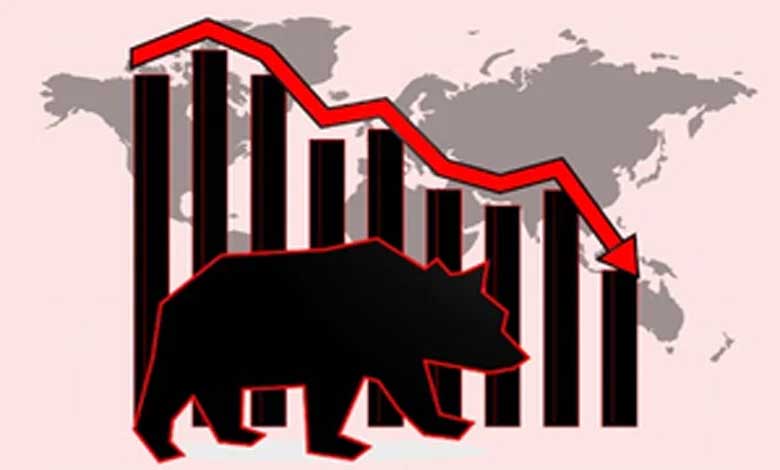Sensex and Nifty Slip in Early Trade Amid Disappointing Macroeconomic Data
The dip in the market was attributed to disappointing macroeconomic data, weak performance in major stocks, and persistent foreign fund outflows, which weighed heavily on investor sentiment.

Mumbai: Indian equity benchmarks, Sensex and Nifty, began the week on a weaker note, registering a significant decline in early trade on Monday.
The dip in the market was attributed to disappointing macroeconomic data, weak performance in major stocks, and persistent foreign fund outflows, which weighed heavily on investor sentiment.
Table of Contents
Sensex and Nifty Performance
- The BSE Sensex plunged 493.84 points, trading at 79,308.95 in early hours.
- Similarly, the NSE Nifty shed 122.45 points, dropping to 24,008.65.
The decline came after both indices witnessed gains on Friday, where Sensex closed at 79,802.79 and Nifty ended at 24,131.10.
Key Laggards and Gainers
In the 30-share Sensex pack, several major stocks underperformed, dragging the market down.
Top Laggards:
- IndusInd Bank
- HDFC Bank
- Larsen & Toubro
- Tata Consultancy Services (TCS)
- Reliance Industries
- Bajaj Finance
- NTPC
- Hindustan Unilever
Top Gainers:
- Maruti Suzuki
- UltraTech Cement
- Adani Ports
- Tata Motors
Macroeconomic Data Impact
India’s GDP growth for the July-September quarter (Q2 FY24) slowed to 5.4%, marking the weakest performance in nearly two years. The slowdown was primarily due to poor performance in the manufacturing and mining sectors, coupled with subdued consumer spending.
Despite the slowdown, India retained its position as the fastest-growing large economy globally. However, the GDP figures dampened market sentiment, especially as part of the slowdown was already factored in post-disappointing Q2 corporate results.
Expert Insights
“The Q2 GDP shocker of 5.4% will weigh on markets, but the impact is unlikely to be large as the market had partially priced in the declining growth following lackluster Q2 corporate earnings,” remarked V K Vijayakumar, Chief Investment Strategist at Geojit Financial Services.
Also Read | Market Outlook: Key Factors to Drive Indian Markets Next Week – RBI MPC, PMI, and Global Economic Data
Foreign Institutional Investor (FII) Outflows
Foreign Institutional Investors (FIIs) continued their selling spree, offloading equities worth ₹4,383.55 crore on Friday. Persistent foreign fund outflows have added pressure to domestic markets, further contributing to the decline.
Global Market Trends
- Asian Markets: Mixed performance, with Seoul trading lower and Tokyo, Shanghai, and Hong Kong posting gains.
- US Markets: Ended positively on Friday, offering some optimism for global investors.
- Oil Prices: Brent crude futures rose by 0.56%, trading at USD 72.24 per barrel, indicating stability in global energy markets.
Sectoral Analysis
The market decline was broad-based, with notable weakness in sectors like:
- Banking and Financial Services: IndusInd Bank and HDFC Bank led the losses, reflecting weaker investor confidence.
- IT Services: Tata Consultancy Services struggled amid global economic uncertainties.
- Energy: Reliance Industries underperformed despite steadiness in crude oil prices.
However, pockets of resilience were visible in:
- Automotive Sector: Stocks like Tata Motors and Maruti Suzuki gained amid improving domestic demand.
- Cement Sector: UltraTech Cement advanced, benefiting from strong infrastructure and construction activity.
Outlook for Investors
The subdued macroeconomic data has prompted a cautious stance among investors. Key factors to watch in the coming days include:
- Inflation Trends: Any further data on inflation could influence market direction.
- Global Economic Developments: Updates from US and Asian markets will provide cues for Indian equities.
- Foreign Fund Flows: Sustained FII outflows may keep the market under pressure.
Conclusion
The decline in Sensex and Nifty in early trade reflects the impact of disappointing macroeconomic data and global uncertainties. While India’s position as the fastest-growing large economy offers some optimism, investors are advised to remain vigilant and monitor sectoral trends closely.
